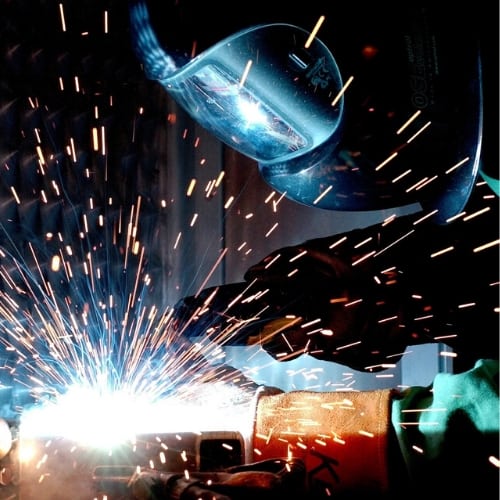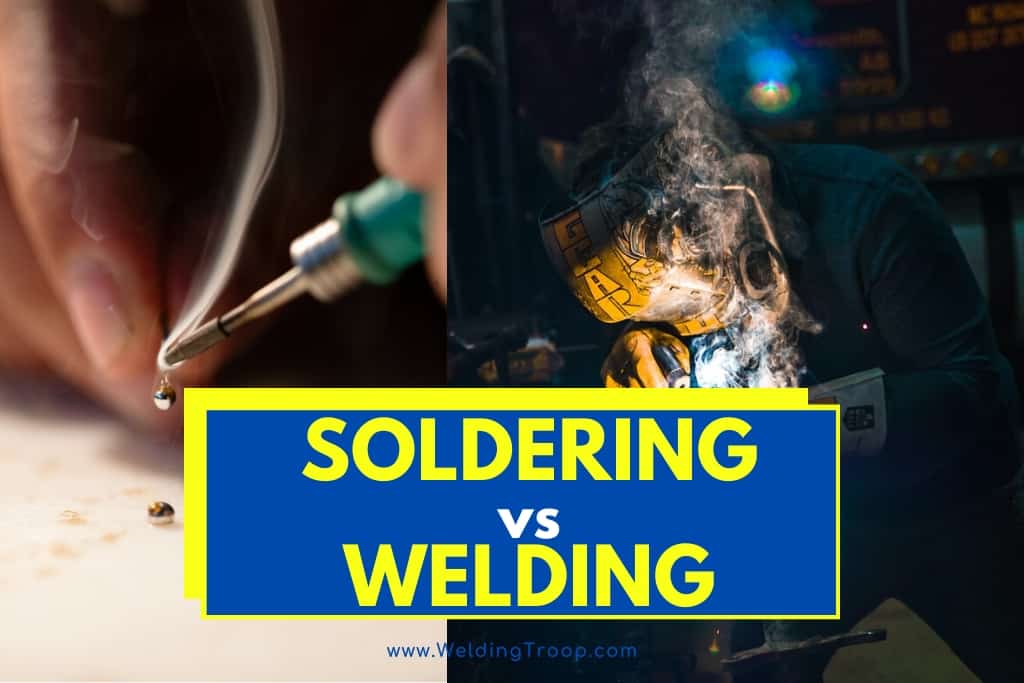Have you ever wondered how to define soldering and brazing? Well, we got you covered.
Soldering vs welding what´s the difference? These two words are sometimes used interchangeably, and although they accomplish the same general goal, they do so differently. What’s the difference between soldering and welding? Soldering and welding are both techniques used to bond metals together, but they accomplish this in different ways. Here are the key differences:
So if you’ve ever wondered about how metals are bonded together in everything from a small piece of jewelry to large scale construction projects, it’s useful to look at the difference between soldering and welding.
Table of Contents
Soldering
Soldering is a technique used to bond metals together by heating solder, which is a metal alloy with a low melting point, and applying it to the pieces that are being bonded together, which are known as the base metals. The pieces being bonded together do not get hot enough to melt, but the solder does, which creates the connection.

Soldering is done at temperatures below 840 degrees Fahrenheit. The exact temperature used will vary depending on what you are doing and the metals that you are bonding but will typically be somewhere between 600 and 700 degrees. It is commonly used for electronic components, but can also be used in other applications, including everything from plumbing to jewelry making.
Equipment
For soldering you need a soldering iron and solder. There are four main types of soldering irons. Soldering pencils and soldering guns are small and easy to use and are best for at-home projects. Soldering guns are a little bit more expensive than pencils and need less time to warm up. A soldering station is a soldering pencil or gun that is attached to a power station that allows you to control the exact temperature of the soldering iron tip. And a repair station is a more complex system that includes additional features and is often used in a commercial facility.
Solder looks like a thin wire that is wrapped around a spool. It was typically made from a mixture of tin and lead. However, as people try to get away from using hazardous materials such as lead, lead-free options have been developed that are made of a combination of tin, silver, and copper. The type of solder that you use will depend on the type of metal that you are working with.
Process
These are the basic steps of soldering:
Soldering is a very delicate process, and it takes practice to gain the skills to get a strong, smooth looking connection with the right amount of solder.
Uses
Soldering is used in a variety of industries, as well as smaller projects that people do at home. It is instrumental in the electronics industry, as it is an effective way to precisely connect small electronic components. The precision that is possible with soldering also makes it a useful tool in the jewelry-making business.
Soldering can also be useful in some more extensive jobs. Although many larger jobs may require a stronger bond, and therefore need to be welded, there are instances where soldering is enough. Plumbing and auto repair are two examples of this. General contractors and roofers may also use soldering for specific tasks.
Brazing
Brazing is a process similar to soldering, but not quite the same. While soldering is done at temperatures below 840 degrees Fahrenheit, brazing uses temperatures above this point, but still below the temperatures needed for welding. However, it still utilizes the same basic principle of using a metal alloy with a low melting point to bond two pieces together.
What Is Brazing Used For?
Brazing is widely used in the tool industry to fasten “hard metal” (carbide, ceramics, cermet, and similar) tips to tools such as saw blades. It is a metal-joining process that involves melting a filler metal with a lower melting point than the adjoining metal.
The filler metal is then brought into contact with the heated parts, creating a metallurgical bond between the filler metal and the surfaces of the two metals being joined using capillary action. Brazing allows for tighter control over tolerances and produces clean joints, making it useful for high-quality production and mass production.
Read also >> What Is Soldering? – An In-depth Guide [Definition, Types, and Meaning]
Read also >> Aluminum Brazing: Complete Guide – Advantages Over Welding
What Gas Is Used For Brazing?
Brazing typically involves the use of fuel gas along with oxygen, and there are several types of gases that can be used for brazing. The most commonly used gases for torch brazing are acetylene, propane, and natural gas.
Further explains that natural gas is preferred for its low flame temperature and is often used in combination with oxygen for brazing applications. The type of gas used will depend on the temperature required for the assembly and the type of metal being brazed.
Why Is Flux Used in Brazing?
Flux is a crucial compound used in brazing to prevent the formation of oxides that inhibit bonding between metals. When metals are heated, oxides can form on their surface, which can prevent the joint from forming correctly. Flux removes these oxides and other impurities from the metal surfaces.
Applying a coating of flux to joint surfaces shields them from the air, preventing oxide formation. Flux must be chosen based on the specific metals, temperatures, and conditions of the brazing application.
It is also important to use enough flux to last throughout the entire heating cycle, and it can act as a temperature indicator.
What is the Temperature of Brazing?
Brazing typically occurs above 840°F (450°C). The actual brazing temperature can vary depending on the brazing filler metal and the base metal alloy being joined, but for most purposes, it is 50°F to 200°F (30°C to 110°C) above the liquidus.
Nickel-based brazing filler metals can be utilized for high-temperature service applications up to 2000°F (1093°C). The selection of a brazing filler metal depends on various factors, such as component design, base metal alloy, and the service environment.
Welding
Welding is a way of joining metals at much higher temperatures than soldering. The exact temperatures vary based on the type of welding and the materials being welded, but are typically above 5,000 degrees Fahrenheit, and in some cases, much hotter than that. And unlike soldering, it melts the base metals and changes their physical properties, therefore creating a stronger bond.
Here, you can find an article from our website about the highest paying welding jobs
Welding is more complicated than soldering and demands more technical knowledge, as it requires the use of electricity or gases and flames that need to be regulated. Many welding jobs require certification as well as numerous safety precautions.

The exact equipment needed will vary depending on the type of welding, but generally speaking, the equipment consists of some kind of welding rig, safety equipment, and material to weld. Welding rigs can vary from simple ones that can be used in home workshops to highly complex ones for industrial use.
Types of Welding
There are many kinds of welding, but they can generally be grouped into two main categories. There’s arc welding, which uses an electric power supply to create an arc between an electrode and the base metal. And there’s torch welding, which uses an oxyacetylene torch.
Arc welding can be further classified into three main types:
- Stick welding, which is also known as shielded metal arc welding, is one of the easier methods to learn.
- MIG welding, or metal inert gas welding, is another method that can be learned easily.
- TIG welding, or tungsten inert gas welding, is more complex and requires a more elaborate setup.
In torch welding, the heat source comes from acetylene and oxygen, which forms a flame. The flame is used to heat the base metals. As the flame heats the metals to a molten form, a filler rod is placed in between the two base metals, and this helps to fuse them together.
There are also newer and more extreme types of welding that include explosion welding, laser beam welding, and ultrasonic welding. Welding can even be done underwater. These are all much more complex and dangerous than arc or torch welding.
Before you continue reading, here is an article we wrote about how to avoid electric shock when welding underwater.
Uses
The uses for welding are far and wide. Construction, automotive, aerospace, and manufacturing are just a few of the industries that rely heavily on welding metals together.
And perhaps a less obvious application for welding is art. Some artists have used welding to make innovative sculptures. Although welding is most often thought of as a technique to build practical structures, some people have expanded that into a creative art form.
You can find a more detailed tutorial on welding here.
Final Thoughts
So whether it’s soldering small electrical components together to make our electronic devices, welding large pieces of metal together to build our bridges, or even creating a beautiful or thought-provoking piece of art, there are countless ways that bonding metals together can be useful. So, the next time you pick up your laptop or drive across a bridge, think about the processes that went into making them.
More Welding Articles
Easiest Way to Learn Welding and How Long Does It Take?
What Is Arc Eye And What Are The Symptoms?
You can find a more detailed tutorial on soldering here.

